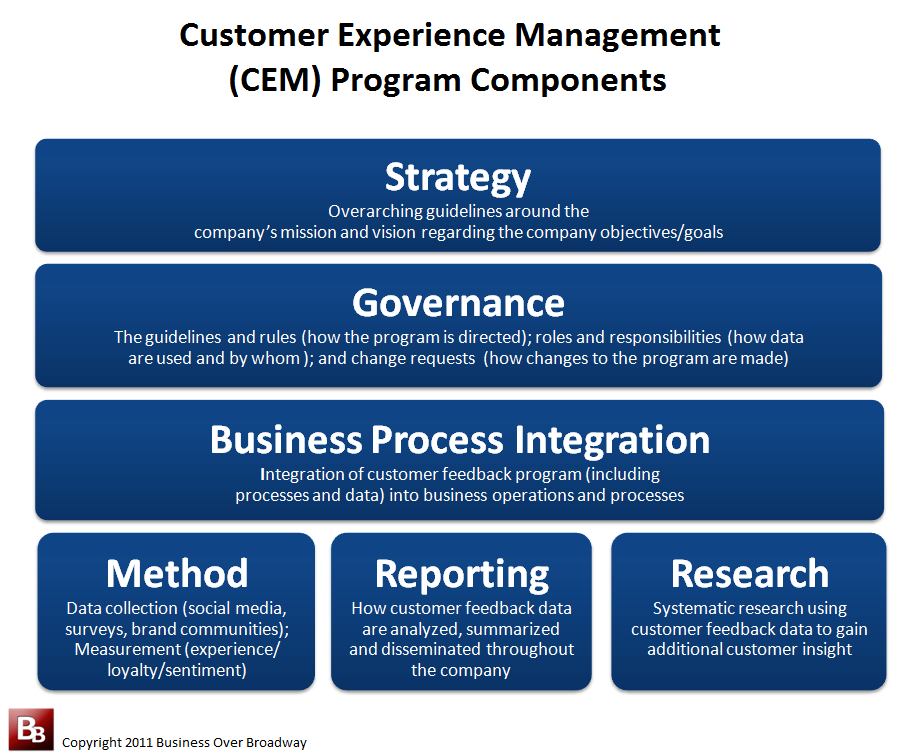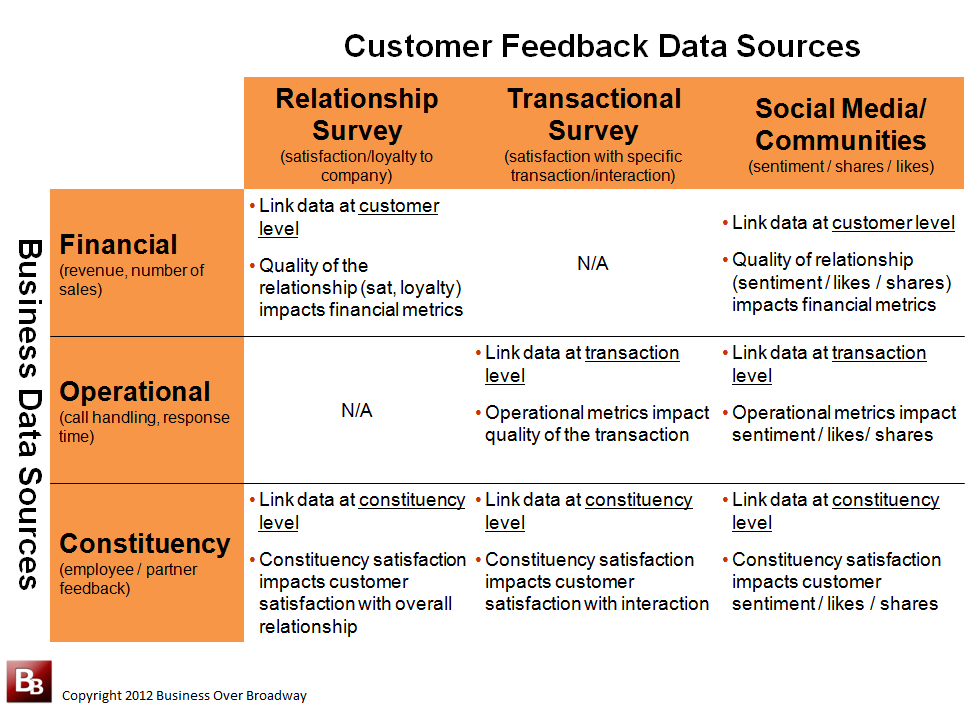
Oracle stands as a great example of a company that builds their business around the customer. In my new book on customer experience management (CEM), TCE: Total Customer Experience, I dedicate a chapter to Oracle’s CEM approach. In this inside look into how one major enterprise structures their CEM program, I explore how Oracle puts theory into practice across each of the six components of Oracle’s CEM program (Strategy, Governance, Business Integration, Method, Reporting and Applied Research – See Figure 1.).
Below are excerpts from that chapter.
Impact of Oracle’s CEM Program
It is one thing to have a customer experience management (CEM) program. It is another thing to track its impact on customers and your business. Oracle monitors and tracks their financial and CEM program metrics to ensure that they are delivering on their promise to help customers succeed. As a result, Oracle reaps the benefits financially: in fiscal year 2012, Oracle’s annual revenue reached US$37.1B, up from US$11.1B in FY05.
During the same time frame, Oracle has seen significant improvements in its CX metrics. First, the Customer Loyalty Index (CLI) has been steadily rising. This increase in customer loyalty is paralleled by improvements in satisfaction in other key metrics like perceived value, quality of relationships and support. Not surprisingly, during this same period, the time to resolve customer-specific issues identified through surveys has declined three fold.
Looking regionally at customer decision makers and influencers, a number of statistically significant increases in satisfaction with relationship-based measures are reported year-over year (book contains graphs of Oracle’s customer loyalty trends).
Strategy and Governance
Oracle’s success rests on having a clear understanding of their customers’ needs and goals. They know that, to deliver an excellent customer experience, they have to provide industry leading solutions that solve customers’ problems and are delivered by experts who are focused on their success. To accomplish this, Oracle uses customer feedback to help senior executives develop long-term strategic plans. The success of Oracle’s CEM program is measured through account-specific relationship surveys. As Oracle President Mark Hurd reinforces,
“We have a sophisticated account planning process that looks at the overall customer relationship across a rolling three-year time horizon. The account plan is a collaboratively developed approach to assuring the customer’s longer-term objectives are met at the same time that Oracle’s objectives are met.”
Mark Hurd, President, Oracle
Deep data governance is of central importance to Oracle. Oracle receives massive amounts of customer feedback annually. In fact, their surveys and panels alone capture over 550,000 responses each year. Consequently, proper program governance is necessary to ensure proper use of this complex web of customer data. Executives demand reliable, valid and useful information when they make their decisions, and data governance can go a long way to ensure they receive high-quality data to help them make the right decisions.
Business Integration
Business integration means a couple of things. First, it means to incorporate customer feedback data into daily business processes. For example, call center agents, at a glance, can understand many different, yet complementary things about the customer: his prior interactions as well as his attitudes about those interactions. By integrating business data, you are able to provide the information your agents need to tailor their interactions with the customer. Knowing a premier caller (based on CRM system) had a recent negative experience (based on transactional survey), your call center agent’s time might be better spent repairing the relationship rather than up-selling. Second, business integration means the process of integrating all business data to allow for a better understanding of large customer segments. Integration of business data is about applying appropriate analytics to these different business metrics (e.g., operational, financial, customer satisfaction/loyalty) to uncover what is responsible for creating happy, loyal customers.
To assist with this, Oracle reports the information using their Customer Relationship Management (CRM) and Business Intelligence (BI) systems. Customer feedback responses requiring follow-up are automatically distributed to pre-determined employees empowered to take ownership, coordinate resources and outreach to the customer and corrective action steps are tracked in Oracle CRM. Historical survey results are stored in Oracle CRM at the contact and account levels, and rolled up using Oracle BI to provide a single repository of role-based customer information for easy account team access.
Method and Reporting
The first piece of advice from Jeb Dasteel, Senior Vice President and Chief Customer Officer at Oracle is to
“implement a cohesive customer feedback program before you do anything else. Demonstrating rigor and credibility in collection, analysis, and presentation of both quantitative and qualitative customer feedback creates a foundation of authority on which you can build all other customer programs.”
Jeb Dasteel, Senior Vice President and Chief Customer Officer, Oracle
Vehicles for capturing customer feedback include:
- Relationship Surveys: Oracle uses relationship surveys to evaluate account management and ongoing relationships. Focused on decision makers and influencers within their customer base, these surveys assess and trend experiences with account management, business practices, services and overall product perceptions across the ownership lifecycle. Post-merger surveys are also conducted to establish baselines, ease the on-boarding process and enable future trending.
- Product Panels: Oracle uses product surveys to assess satisfaction covering 15,000-plus products. Focused on end users, implementers and managers, these panels capture detailed and comparative feedback across the full Oracle product stack, and provide direct two-way communication between customers and Oracle Development General Managers.
- Transactional Surveys: Oracle has a set of transactional surveys that measure how well they execute specific business processes and obligations. Focused on customers at all levels, these surveys assess experiences with specific events, engagements and interactions across the customer lifecycle.
- Targeted Surveys: Tailored by job level and function given the objectives of the study, the aim of targeted surveys is to capture more detailed input on Oracle’s top “customer feedback themes”.
- Market Research: Coupled with surveys and panels, market research provides insight into market trends and competitive perspectives across our install base, prospects and partners.
Oracle applies analytics to customer feedback to help identify key themes. They are much more confident with conclusions based on several lines of evidence than a single line of evidence. As such, customer feedback results from different sources are consolidated, including surveys, customer advisory boards and councils, user groups, executive escalations, root cause analysis, operational measures and financial metrics. Using these different sources of customer feedback, Oracle extracts and publicizes the ten “customer feedback themes” that have the greatest impact on CX and business results.
Applied Research
Oracle regularly conducts deep dive research using their customer experience data. They accomplish this research by linking different metrics from disparate data sources together. Operational linkages, for example, help identify clear operational performance metrics (e.g., first call resolution, call handle time) that truly drive the customer experience; financial linkages allow Oracle to estimate the return on investment of different improvement initiatives; and constituency linkages allow Oracle to invest in effective employee experience programs that ultimately also enhance the customer experience.
Additionally, Oracle takes a longitudinal look at customer feedback data. Rather than solely relying on a cross-sectional view (all data from the same period), Oracle uses a time-series approach to identify cause and effect relationships among metrics, allowing them to make stronger predictive claims about the causes of customer satisfaction and loyalty.
Oracle combines metrics across a variety of different data silos to research many different types of questions. In one research endeavor, Oracle focused in on the support process. Toward that end, they integrated operational support data and end user experience with support to identify the call center metrics that drove caller satisfaction. Additionally, they integrated different types of survey data to examine whether end user support experience (those who used the applications) was related to their management’s experience (decision makers who purchased the applications).
Over the past 3 years, Oracle has been conducting a number of joint research activities with its user groups worldwide, and sharing the results collaboratively with user group leaders, who in turn provide input into potential action plans and strategies. The results of these studies show that customers who are involved with non-user group peers. It appears that customers who are more engaged (e.g., participate in user groups) receive greater value from their investments and, consequently, are happier with Oracle’s solutions.
Final Thoughts
How Oracle operationalizes best practices will likely be different than many other companies. Like any company-wide initiative, you need to work within your company’s constraints when considering how you will support CEM best practices. For example, while Oracle shares their customer feedback results across a variety of mediums, a smaller company will have fewer mediums to leverage. Yet both companies share the same spirit in communicating results to the company.
Oracle’s CEM program has come a long way in the last decade. As an example, in 2005, Oracle was executing multiple relationship surveys using various tools and methodologies, which made comparability across key customer segments extremely difficult. As mergers and acquisitions activity accelerated, the need to centralize surveys became clear and a requirement to providing stronger insight across their growing product footprint and expanding customer base. An enormous effort went into consolidating tools, standardizing methodologies, and globalizing processes. This in turn created opportunities to integrate processes and technologies, drive efficiencies into day-to-day operations, and create new demand for other business questions. While Oracle’s CEM program scope continues to expand, and operations continue to evolve, one central element remains the same: maintaining a centralized, coordinated approach for listening to, responding to and collaborating with customers.
————————–
Buy TCE: Total Customer Experience at Amazon >>
In TCE: Total Customer Experience, learn more about how Oracle integrates their business data around the customer and applies a customer-centric analytics approach to gaining deeper customer insights.





